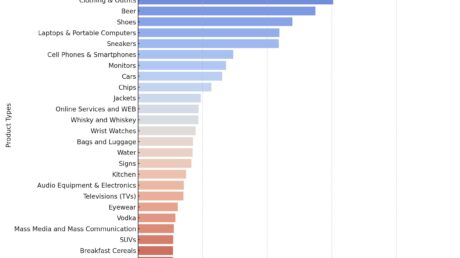There’s no doubt that entertainment marketing is fun, whether you’re activating a campaign on behalf of a brand or executing an integration on set, there’s a sort of je ne sais quoi around contributing to authentic storytelling. Unfortunately, fun doesn’t pay the bills – I know, we’re bummed out too – and entertainment marketing needs to prove its impact on ROI just like the rest. As the marketing and advertising industries continue to prioritize high-ROI strategies, we’re here to demonstrate the measurable impact of product placement marketing and its contribution to your overall strategy.
Product placement campaigns offer measurement solutions that evaluate the success of integrations based on primary objectives. Custom research capabilities include opportunities to analyze full-funnel metrics that help determine the impact integrations have on consumer awareness, perception, and action. We’ll cover the significance of an integration’s reach and its contribution to the success of brand lift studies, attribution reports, and media mix models.
Reach
Similar to traditional advertising, reach isn’t a campaign metric we hang our hats on. Instead, depending on your entertainment media partner, it’s an agreed-upon metric of impressions that helps measure campaign milestones. The reach of an individual integration is an important variable that aids in understanding an integration’s relative impact on the overall product placement program and its contribution toward brand awareness objectives.
Brand Lift Studies
Discovering consumers’ perceptions around brand awareness, affinity, and consideration is just as important as lower-funnel attribution metrics. Thoughtfully crafting a brand lift study after integrations have aired allows your team to understand how well consumers are able to recall the brand/product, and whether the integration hit its mark or if it gave consumers the ick. There’s more to integrations than making sure the label is easily identifiable and on-screen for 3 to 4 seconds, and brand lift studies help tune your brand objectives to what consumers identify as authentic versus forced.
Understanding how audiences perceive your brand and its alignment with the content helps create meaningful, creative, and relevant product and brand integrations that will resonate with audiences, and most importantly, drive action with your target consumer. A brand lift study is capable of uncovering consumer sentiments around story alignment, integration authenticity, consumer relevance, and purchase intent to reveal meaningful results that allow execution teams to optimize your campaign strategy.
Attribution Reports
Discovering more tangible results requires your media partner to tap into data sets of exposed and unexposed audiences. With your primary objectives in mind, attribution reports are designed to measure the relative lift of website visits, in-store traffic, or even sales garnered during a predetermined attribution window. There are various scenarios that benefit from both brand lift studies and attribution reports but if your brand is looking for tangible results straight off the TV screen it’s best to align with content that can deliver integrations that inspire action among audiences. Your content partner will guide you through suggested content that positions your brand to drive actionable results through a cultural strategy that delivers optimal situational salience.
Mix Media Model (MMM)
The key to a successful product placement strategy includes integrating the results into an existing Media Mix Model (MMM). As MMM’s implement the use of multi-linear regression models, product placement results can further help marketers determine the impact of entertainment campaigns on overall marketing objectives. Integrating product placements into an existing MMM is recommended for brands interested in using aggregate data to help refine a scaled entertainment campaign with a high-volume of placements that reach a range of global audiences.
Understanding the Value of Product Placement
Measuring the value of a product placement is another effective way of proving ROI of a product placement marketing campaign. Similar to measuring media value on traditional marketing formats, earned media value for product placement is the monetary value of the placement exposure put into a quantitative dollar amount representing what is presumed to have been the same engagement through paid branded marketing channels. However, calculating media value for product placement is not exactly 1:1 as it would be for other paid marketing channels, and there are several industry leaders creating their own methodology for calculating media value for product placement moments.
SEE HERE for a recent article on YouGov and the PQS tool for example.
Set Clear Objectives
Product placement offers a variety of benefits to brands, from reaching non-ad-supported audiences, and delivering perpetual impact and results well past the window of reporting, to measurable results across key brand objectives such as awareness, consideration, and even sales. The key to successfully proving product placement’s effectiveness, and reaping the benefits of an impactful campaign, is first understanding what success looks like to you as a brand.
Establishing clear goals at the planning stage of a product placement campaign is essential to building the right product placement approach for your brand. Considering which key objectives are a priority allows your entertainment partner to identify a content strategy – and ultimately which form (or mix) of measurement best evaluates the performance towards the campaign’s goals.




